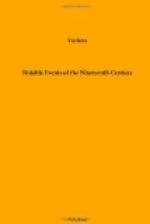EVOLUTION OF THE TELESCOPE.
The development of telescopic power within the present century is one of the most striking examples of intellectual progress and mastery in the history of mankind. The first day of the century found us, not, indeed, where we were left by Galileo and Copernicus in the knowledge of the skies and in our ability to penetrate their depths, but it did find us advanced by only moderate stages from the sky-lore of the past.
The after half of the eighteenth century presents a history of astronomical investigation and deduction which confirmed and amplified the preceding knowledge; but that period did not greatly widen the field of observation. If the sphere of space which had been explored on the first day of January, 1801, could be compared with that which is now known and explored by our astronomers, the one sphere would be to the other even as an apple to the earth.
It is difficult to apprehend the tremendous strides which we have made in the production of telescopes and the consequent increase in our sweep of the heavens. It was only in 1774 that the elder Herschel began his work in the construction of reflecting telescopes. These he gradually increased in size, until near the close of the century, when he produced an instrument which magnified two hundred and twenty-seven diameters. In the course of his career he built two hundred telescopes, having a seven-foot focus; 150 of ten feet and about eighty of twenty feet each.
With these instruments the astronomical work in the last quarter of the eighteenth century was mostly performed. The study of the heavens at this epoch began to reach out from the planetary system to the fixed stars. In this work Herschel led the way. The planet Uranus at first bore the name of Herschel, from its discoverer. Sir John Herschel, son of Sir William, was born in 1792. All of his astronomical work was accomplished in our century. Following the line of his father, he used the reflecting telescope, and it was an instrument of this kind that he took to his observatory at the Cape of Good Hope. Lord Rosse was born in the year 1800. Under his auspices the reflecting telescope reached its maximum of power and usefulness. His great reflector, built in his own grounds at Birr Castle, Ireland, was finished in 1844. This instrument was the marvel of that epoch. It had a focal distance of fifty-three feet, and an aperture of six feet. With this great telescope its master reached out into the region of the nebulae, and began the real work of exploring the sidereal heavens.
In the reflecting telescope, however, there are necessary limitations. Before the middle of this century, it was known that the future of astronomy depended upon the refracting lens, and not on the speculum. The latter, in the hands of the two Herschels and Rosse, had reached its utmost limits—as is shown by the fact that to this day the Rosse telescope is the largest of its kind in the world.




